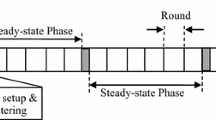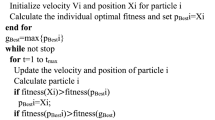Abstract
Wireless sensor networks are used for low-cost unsupervised observation in a wide-range of environments and their application is largely constrained by the limited power sources of their constituent sensor nodes. Techniques such as routing and clustering are promising and can extend network lifetime significantly, however finding an optimal routing and clustering configuration is a NP-hard problem. In this paper, we present an energy efficient binary particle swarm optimization based routing and clustering algorithm using an intuitive matrix-like particle representation. We propose a novel particle update strategy and an efficient linear transfer function which outperform previously employed particle update strategies and some traditional transfer functions. Detailed experiments confirmed that our routing and clustering algorithm yields significantly higher network lifetime in comparison to existing algorithms. Furthermore, our results suggest that Binary PSO is better equipped to solve discrete problems of routing and clustering than its continuous counterpart, PSO.

























Similar content being viewed by others
Notes
Gateways can also be deployed using a gaussian distribution centred at the coordinates of the base station. We will discuss deployment strategies in greater detail in Sect. 7.
This is true for routing particles. For clustering particles, the \(V_k(i, j)\) instead, indicates the probability that the SN \(s_j\) is assigned to the CH \(c_i\).
The probability of routing to \(c_i\) or \(c_k\) must be larger than any other CH.
Since the \(S_r\) array which stores the routing solution is an output, it is not counted into space complexity.
It must be noted that the following solutions are not exhaustive.
Maximum forwarding energy of any gateway in the network.
Refer Kuila and Jana [20] for more details.
References
Bansal, J. C., & Deep, K. (2012). A modified binary particle swarm optimization for knapsack problems. Applied Mathematics and Computation, 218(22), 11042–11061.
Bari, A., Jaekel, A., & Bandyopadhyay, S. (2008). Clustering strategies for improving the lifetime of two-tiered sensor networks. Computer and Communications, 31(14), 3451–3459. https://doi.org/10.1016/j.comcom.2008.05.038.
Bari, A., Wazed, S., Jaekel, A., & Bandyopadhyay, S. (2009). A genetic algorithm based approach for energy efficient routing in two-tiered sensor networks. Ad Hoc Networks, 7(4), 665–676. https://doi.org/10.1016/j.adhoc.2008.04.003.
Baronti, P., Pillai, P., Chook, V. W., Chessa, S., Gotta, A., & Hu, Y. F. (2007). Wireless sensor networks: A survey on the state of the art and the 802.15. 4 and zigbee standards. Computer Communications, 30(7), 1655–1695.
Calhoun, B. H., Daly, D. C., Verma, N., Finchelstein, D. F., Wentzloff, D. D., Wang, A., et al. (2005). Design considerations for ultra-low energy wireless microsensor nodes. IEEE Transactions on Computers, 54(6), 727–740. https://doi.org/10.1109/TC.2005.98.
Chatterjee, S., Sarkar, S., Hore, S., Dey, N., Ashour, A. S., & Balas, V. E. (2017). Particle swarm optimization trained neural network for structural failure prediction of multistoried RC buildings. Neural Computing and Applications, 28(8), 2005–2016.
Dietrich, I., & Dressler, F. (2009). On the lifetime of wireless sensor networks. ACM Transactions on Sensor Networks (TOSN), 5(1), 5.
Ebrahimi Mood, S., & Javidi, M. (2019). Energy-efficient clustering method for wireless sensor networks using modified gravitational search algorithm. Evolving Systems. https://doi.org/10.1007/s12530-019-09264-x.
Ghamisi, P., & Benediktsson, J. A. (2015). Feature selection based on hybridization of genetic algorithm and particle swarm optimization. IEEE Geoscience and Remote Sensing Letters, 12(2), 309–313.
Gupta, G., & Younis, M. (2003). Load-balanced clustering of wireless sensor networks. In IEEE international conference on communications, 2003. ICC ’03 (Vol. 3, pp. 1848–1852). https://doi.org/10.1109/ICC.2003.1203919
Gupta, G., & Younis, M. (2003). Performance evaluation of load-balanced clustering of wireless sensor networks. In 10th international conference on telecommunications, 2003. ICT 2003 (Vol. 2, pp. 1577–1583). IEEE.
Gupta, S. K., Kuila, P., & Jana, P. K. (2013). GAR: An energy efficient GA-based routing for wireless sensor networks. In International conference on distributed computing and internet technology (pp. 267–277). Springer.
Heinzelman, W. R., Chandrakasan, A., & Balakrishnan, H. (2000). Energy-efficient communication protocol for wireless microsensor networks. In Proceedings of the 33rd annual Hawaii international conference on system sciences (p. 10). IEEE.
Heinzelman, W. B., Chandrakasan, A. P., & Balakrishnan, H. (2002). An application-specific protocol architecture for wireless microsensor networks. IEEE Transactions on Wireless Communications, 1(4), 660–670. https://doi.org/10.1109/TWC.2002.804190.
Izakian, H., Ladani, B. T., Abraham, A., & Snásel, V. (2010). A discrete particle swarm optimization approach for grid job scheduling. International Journal of Innovative Computing, Information and Control, 6, 1–15.
Jaichandran, R., Anthony, I. A., & Emerson, R. J. (2010). Effective strategies and optimal solutions for hot spot problem in wireless sensor networks (WSN) (pp. 389–392). https://doi.org/10.1109/ISSPA.2010.5605518.
Kaur, S., & Mahajan, R. (2018). Hybrid meta-heuristic optimization based energy efficient protocol for wireless sensor networks. Egyptian Informatics Journal, 19(3), 145–150.
Kennedy, J., & Eberhart, R. (1995). Particle swarm optimization (PSO). In Proceedings of IEEE international conference on neural networks, Perth, Australia (pp. 1942–1948).
Kennedy, J., & Eberhart, R. C. (1997). A discrete binary version of the particle swarm algorithm. In 1997 IEEE international conference on systems, man, and cybernetics. Computational cybernetics and simulation (Vol. 5, pp. 4104–4108). IEEE.
Kuila, P., & Jana, P. K. (2014). Energy efficient clustering and routing algorithms for wireless sensor networks: Particle swarm optimization approach. Engineering Applications of Artificial Intelligence, 33, 127–140. https://doi.org/10.1016/j.engappai.2014.04.009.
Kuila, P., Gupta, S., & Jana, P. (2013). A novel evolutionary approach for load balanced clustering problem for wireless sensor networks. Swarm and Evolutionary Computation, 12, 48–56. https://doi.org/10.1016/j.swevo.2013.04.002.
Liu, X. (2012). A survey on clustering routing protocols in wireless sensor networks. Sensors, 12(8), 11113–11153. https://doi.org/10.3390/s120811113.
Low, C. P., Fang, C., Ng, J. M., & Ang, Y. H. (2008). Efficient load-balanced clustering algorithms for wireless sensor networks. Computer and Communications, 31(4), 750–759. https://doi.org/10.1016/j.comcom.2007.10.020.
Pedrasa, M. A. A., Spooner, T. D., & MacGill, I. F. (2009). Scheduling of demand side resources using binary particle swarm optimization. IEEE Transactions on Power Systems, 24(3), 1173–1181.
Shi, Y., & Eberhart, R. C. (1999). Empirical study of particle swarm optimization. In Proceedings of the 1999 congress on evolutionary computation-CEC99 (Cat. No. 99TH8406) (Vol. 3, pp. 1945–1950). IEEE.
Souissi, M., & Meddeb, A. (2016). Minimum energy multi-objective clustering model for wireless sensor networks (pp. 769–773). https://doi.org/10.1109/IWCMC.2016.7577154.
Srinivasa Rao, P. C., & Banka, H. (2017). Energy efficient clustering algorithms for wireless sensor networks: Novel chemical reaction optimization approach. Wireless Networks, 23(2), 433–452. https://doi.org/10.1007/s11276-015-1156-0.
Tang, J., Hao, B., & Sen, A. (2006). Relay node placement in large scale wireless sensor networks. Computer and Communications, 29(4), 490–501. https://doi.org/10.1016/j.comcom.2004.12.032.
Taormina, R., & Chau, K. W. (2015). Data-driven input variable selection for rainfall-runoff modeling using binary-coded particle swarm optimization and extreme learning machines. Journal of Hydrology, 529, 1617–1632.
Taşgetiren, M. F., & Liang, Y. C. (2003). A binary particle swarm optimization algorithm for lot sizing problem. Journal of Economic and Social Research, 5(2), 1–20.
Thilagavathi, S., & Geetha, B. G. (2015). Energy aware swarm optimization with intercluster search for wireless sensor network. The Scientific World Journal. https://doi.org/10.1155/2015/395256.
Yigitel, M. A., Incel, O. D., & Ersoy, C. (2011). QoS-aware mac protocols for wireless sensor networks: A survey. Computer Networks, 55(8), 1982–2004. https://doi.org/10.1016/j.comnet.2011.02.007.
Younis, O., & Fahmy, S. (2004). Heed: A hybrid, energy-efficient, distributed clustering approach for ad hoc sensor networks. IEEE Transactions on Mobile Computing, 03(4), 366–379. https://doi.org/10.1109/TMC.2004.41.
Author information
Authors and Affiliations
Corresponding author
Additional information
Publisher's Note
Springer Nature remains neutral with regard to jurisdictional claims in published maps and institutional affiliations.
Rights and permissions
About this article
Cite this article
Kaushik, A., Goswami, M., Manuja, M. et al. A Binary PSO Approach for Improving the Performance of Wireless Sensor Networks. Wireless Pers Commun 113, 263–297 (2020). https://doi.org/10.1007/s11277-020-07188-3
Published:
Issue Date:
DOI: https://doi.org/10.1007/s11277-020-07188-3




